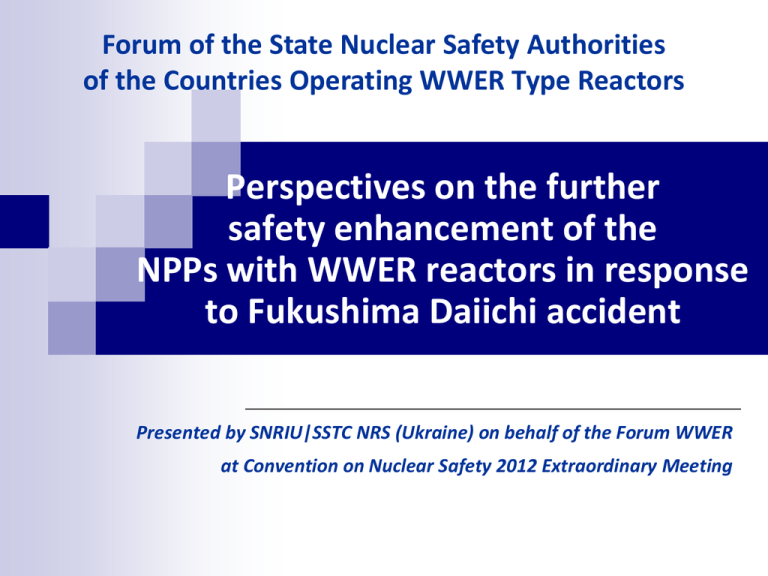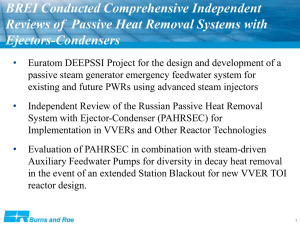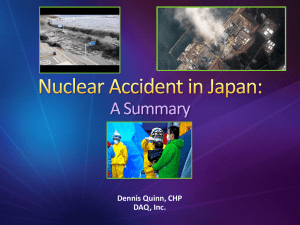Presented - Forum of the State Nuclear Safety Authorities of the
advertisement

Forum of the State Nuclear Safety Authorities of the Countries Operating WWER Type Reactors Perspectives on the further safety enhancement of the NPPs with WWER reactors in response to Fukushima Daiichi accident Presented by SNRIU|SSTC NRS (Ukraine) on behalf of the Forum WWER at Convention on Nuclear Safety 2012 Extraordinary Meeting Key facts about WWER Forum WWER Forum established in 1993, 11 members and observers from GRS and IAEA Objectives: to provide the network of chief nuclear safety regulators with WWER for exchanging experience to discuss, harmonize and develop the common approach for relevant safety issues 2 Key facts about WWER Forum WWER Forum combines regulators supervising: 54 WWER units in operation (39,59 GWe) 14 under construction Working methods: annual high level meetings supported by topical Working Groups 300 250 Number of reactors 200 54 216 150 100 84 47 50 17 15 2 0 PWR Other PWR BWR WWER GCP PHWR LWGR FBR Reactor type IAEA. Reference data series No. 2, Nuclear Power Reactors in the World (31 DEC. 2011) 3 Targeted safety re-assessment (stress tests) All WWER-operating countries re-assessed NPP robustness as a short-term measure in response to Fukushima event: EU WWER countries (Bulgaria, Czech Republic, Finland, Hungary, Slovak Republic) and Ukraine performed stress tests in compliance with ENSREG specifications and participated in respective peer review process Russian Federation performed stress tests in compliance with ENSREG specifications and Armenia is in the process China and India performed comprehensive targeted safety re-assessment in a stand alone manner (in India scope has been similar to EU stress tests) 4 Overview of the stress-tests results Stress-tests have not revealed any significant external hazards or their combinations that have not been considered in the initial design and/or in SARs/PSRs WWER plants are reliable to ensure safety functions: WWER-440, very large design safety margins, robust components, high redundancy of safety systems, large water inventory in primary and secondary sides WWER-1000 (Gen II), design and safety systems comparable to PWR’s of the same generation WWER-1000/AES-92, AES-2006 (Gen. III+) new designs with enhanced inherited safety features, wide use of passive safety tools Since their first start-up, all operating WWER plants have implemented a number of safety measures that have further increased reliability of the safety functions Additional prompt measures have been implemented immediately after Fukushima accident 5 Safety functions Three main safety functions have to be provided for an extended time under all hazardous conditions reactivity control decay heat removal containment of radioactive material Enhanced back-up to the original power supply systems has to be provided for safety functions at operating WWERs 6 Reactivity control Original design features Implemented measures Further upgrades (SBO conditions) Gen II WWER designs (ref. WWER-1000) • • • scram (control rods) high boron concentration HPIS (3x100%, 40 g/kg) HPIS (3x100%, 16 g/kg) • make up system after • high boron containment concentation HPIS + isolation (HPIS back small DG up) (boron water injection to primary circuit to compensate LOCA through pump seals and prevent re-criticality on long term heat removal) New WWER designs • increased number and efficiency of the control rods ensure subcriticality in long term also at low temperatures (< 100 °C) • passive high concentration boron injection system 7 Decay heat removal Original design features Implemented measures Further upgrades (SBO or/and HS loss) Gen II WWER designs • primary heat removal by same system as in LB LOCA (3x100% ECCS) • secondary heat removal (2x100% AFWS, 3x100% EFWS) • • • • • primary F&B secondary F&B “super” EFWS using diesel driven pumps (WWER-440) passive SG make up (after pressure relief) from FW tank SG make up from fire-fighting trucks • SG make up from mobile sources New WWER designs Passive core flooding system (HA-II), additional closed-loop SG cooldown system (2x100%), passive system in secondary circuit (4x33%) , steam condensing by air flow 8 Examples of the implemented measures (Rivne 1&2, South-Ukraine NPP) 9 Containment of the radioactive material Original design features Implemented measures Further upgrades Gen II WWER designs • large containment with spray system • containment with bubble condenser (WWER-440) Severe accident management tools were not considered in the original plant design • • • • • • special system for large primary to secondary leak management hydrogen management containment filtered venting instrumentation for severe accident conditions RPV ex-vessel cooling (WWER-440) measures on severe accident management at exvessel phase (WWER-1000 under consideration) New WWER designs Double containment, annulus passive filtering system, passive containment heat removal system, containment hydrogen monitoring and catalytic recombination systems, core catcher with passive heat removal 10 Examples of the implemented measures (Loviisa 1 & 2) 4. Containment pressure control • External spray 3. Hydrogen control • Ice condenser doors • Recombiners • Glow plug improvement 5. Containment isolation • Manual actuation as back-up • Monitoring of leak-tightness • Leakage control 1. Primary system depressurisation 2. Melt retention within pressure vessel • • • • 6. Severe accidents instrumentation & control Inlet valves Steam outlet Lowering the neutron shield Debris removal 11 AC power as support for safety function Original design features Implemented measures Further upgrades (SBO conditions) Gen II WWER units • emergency power supply system (3x100% or 4x100%) • common-unit DGs at site • increase of the battery capacity, optimizations of the consumers list • interconnection between on-site power supply sources • various off-site power supply options • • mobile power sources (small portable DGs, powerful mobile DG station – already implemented at some plants) improving reliability of fixed on-site power supply (diverse cooling of DGs) 12 Examples of the implemented measures 2 MW MDG in Novovoronezh NPP MDG in Kozloduy NPP 13 13 Advanced systems in new WWER plants New WWERs have adequate built in systems to withstand prolonged loss of power as well as loss of UHS: • long term cooling of the reactor core without AC power, •long term decay heat removal that is not relying on primary ultimate heat sink, and •protection of reactor containment integrity after potential core meltdown accident Safety systems (passive HAs + passive heat removal system) allow to avoid core damage even in case of Large Break LOCA in coincidence with SBO Passive decay heat removal from SGs (NVNPP-2) Filters Passive filtration draft pipes Hot air Annulus Hydrogen recombiners PHRS Steam generator Atmospheric air PHRS Atmospheric air Reactor • Separate passive system maintains vacuum in the annulus and filters possible radioactive leaks from inner containment • The passive heat removal system is intended for longterm removal of the reactor residual heat when there are no sources of power supply; it can operate both with the intact reactor coolant system and when leaks of reactor coolant occur • The system consists of four independent (4x33%) loops for natural circulation of the secondary coolant • Each loop has air ducts for passive removing of decay heat to the atmosphere, and direct-action passive devices that control the air flow rate Further challenges from regulatory point of view reinforcement of current regulations to extend the design basis with severe accident management provisions improvement of the technical features and infrastructure to respond effectively to severe accidents that may affect multiple units for extended periods ensuring synergy between safety and security 16 Conclusions Fleet of WWER units has a robust inherent design features which have been further substantially improved during last two decades. Additional ‘immediate’ actions have been implemented shortly after Fukushima event. Fukushima accident provides insights for further safety strengthening of old WWER plants and for extending the scope of issues to be addressed in new designs Extended measures should be continually taken to encourage all countries to improve their compliance with IAEA standards and follow transparency and openness principles 17





